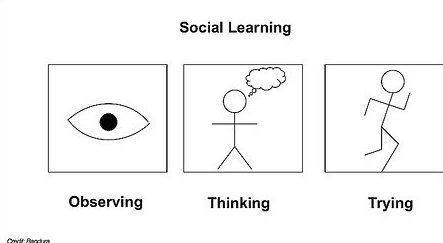“Imitation is not just the sincerest form of flattery…. It is also the sincerest form of learning !” – George Bernard Shaw.
Social Learning has been evolving as an important part of overall organizational development and culture change since it was propounded by Albert Bandura in the sixties. It has evolved in to further areas like Social Cognitive Theory, Social Modeling, Connectivism, etc adding depth and dimensions to this aspect of human learning.
Recently, when I was discussing Corporate culture with a senior corporate leader, he jokingly said “ Want to know your real organizational culture? Listen to what people talk about and how they behave during lunch or around the coffee machine!”
Seems a bit stretched but may not be far from the truth. So what really happens between the formal communication or training delivered down the hierarchy, and the final resultant cultural behavior of the organization ? Maybe the answer lies in the social learning process.
So what is Social Learning? Though it has been explained in a scientific manner in the recent past, Social learning supposedly is a fundamental human trait. It is the process of learning through watching others, mimicking and learning from the environment. Babies start doing it when they are barely two months old, and so the baby smiling back at you might just be mimicking you and learning to relate a feeling of happiness with that expression. As we grow, our parents, peer group and teachers are sources of learning as we develop our abilities to express ourselves, manage conflicts and succeed in life. Lately, even Neuroscience has identified “ Mirror Neurons” as the pathways that help humans mimic others and learn from them.
So how is Social Learning critical to Culture change in an organization? As per experts, Social learning is that informal learning process that also takes over after the formal/structured training are over. As people engage in talk over the coffee machine/lunch table or discuss business in various situations, they look at each other, talk , listen and mimic to develop themselves in the desired direction. This happens all the time and subliminally builds the culture of the organization. The key challenge here is that Social learning may not happen in a controlled environment and so the eventual outcome would not be as desired.
Thus, in most organizations, the Social Learning process is critical but uncontrolled , continually adding significantly to the Organizational Culture.
So what could the leaders do to steer this process in the desired direction? A difficult question which may not be answered satisfactorily in a post, and may not be one solution to all. My little experience in discussing with various leaders has seemed to highlight a few broad measures in this direction:
- Consistent and regular communication : One cannot ever undermine the importance of communication. It should be consistent, clear and regular. The intention is to swamp the irrelevant communication with what is important to be discussed, when people interact informally with each other ( whether for business or at lunch ).
- Walk the Talk : Social Learning is about learning from watching and mimicking others, specially leaders. The silent behavior of leaders has to be consistent with the cultural change desired in the organization. Mentoring by leaders could also help, for helping people develop in the desired manner.
- Candid Feedback : A lot of communication coming down the hierarchy becomes a game of “ monkey’s whisper”, where the information to the last person is quite distorted. Leaders and people driving the culture change should take time for getting real feedback on what has been understood and being discussed among the employees.
- Reward and Punishment : The famous “Bobo Doll experiment” of Albert Bandura revealed that reward /punishment for a specific activity helps people learn how and when to do it. Regular and clear communication is critical to use this effectively.
- Corporate Stories : Story telling has been seen as a powerful tool for social learning. Mythological stories help us understand the ideal behavior in different situations, encouraging us to “mimic” the heroes for building our self worth. Similarly, corporate stories, both positive and negative help bring to life the possibilities, constraints and “optimal path” for achieving success.
- Coaching : Internal or external coaching could help employees sift through the myriad challenges, situations at the workplace and prioritize on areas of development , aligned to the Organizational culture.
Social Learning, which eventually evolved into the Social Cognitive Theory and various sub areas of research, is a very large subject. But it’s worth exploring for leaders who are building Organizational culture and trying to bridge the gap between structured training/development and the eventual resultant behavior at the bottom of the hierarchy.
Any thoughts or feedback is welcome !





Post a comment